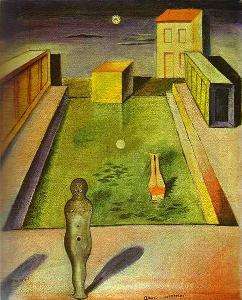Aquis Submersus
 | |
| Artist | Max Ernst |
|---|---|
| Year | 1919 |
| Medium | Oil on canvas |
| Dimensions | 54 cm × 43.8 cm (21.26 in × 17.24 in) |
| Location | Städelsches Kunstinstitut und Städtische Galerie, Frankfurt |
Aquis Submersus (Latin for Water Drowning) is a painting by the German dadaist and surrealist Max Ernst created in 1919. Influenced by the Italian metaphysical art it is one of Ernst's earliest works showing surrealistical accents.[1] It currently resides at the Städel museum in Frankfurt, Germany.[1]
The painting depicts a swimming pool surrounded by buildings. The sense of dimension is unclear. The features of the buildings appear to be hand-drawn. The buildings leave shadows against the sky like a wall. Hanging in the sky is a clock that reflects on the water as a moon. In the pool, the picture shows a possibly female or childish body in an upside-down position with only the waist and legs above the water level. The person appears to be diving or is drowning. In the foreground is an armless stature-like figure that appears to have been made out of clay, throwing a shadow in the direction of the pool, similar to another shadow originating from outside the picture. The person looks away from the pool and bears a handlebar mustache resembling that of Ernst's father, but also has features which could be interpreted as female.
The painting carries the same name as a famous novella Aquis submersus by Theodor Storm, published in 1876, which influenced Ernst creating his painting.[1]
References
- 1 2 3 "Aquis submersus". Städelmuseum, Frankfurt. Retrieved 2013-05-09. External link in
|publisher=(help)
Sources
- The Guardian - Analysis of Pietà or Revolution by Night that describes Ernst's father.